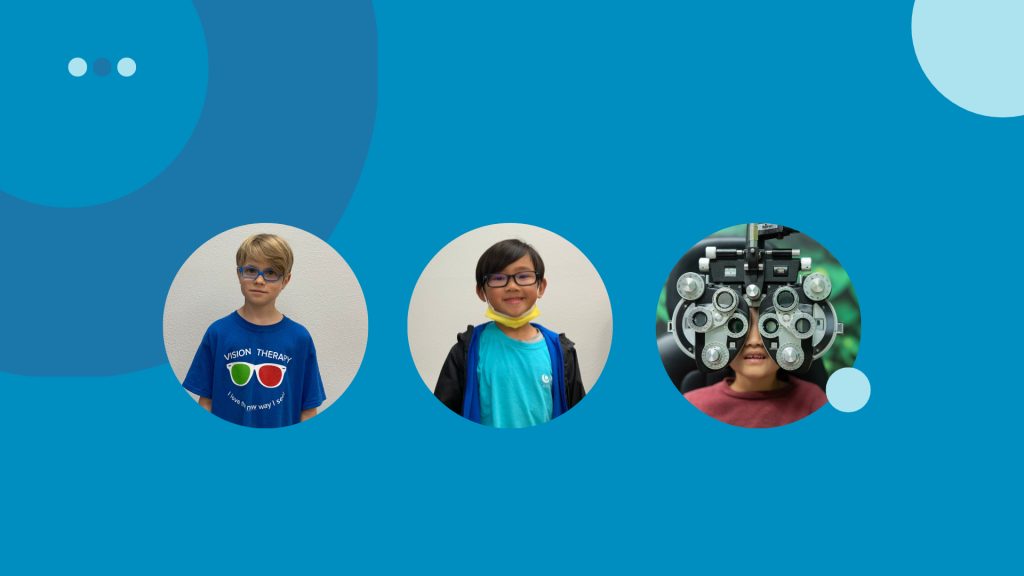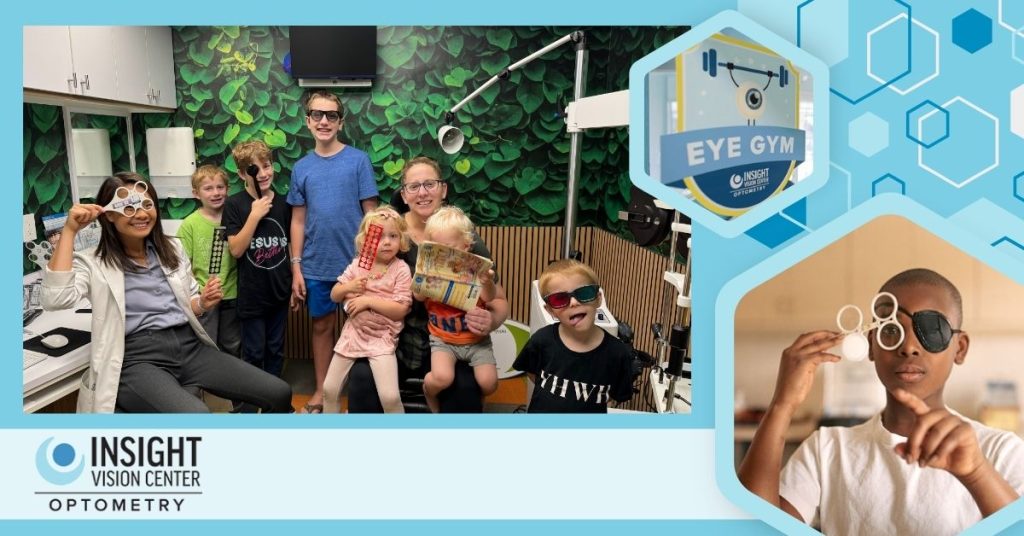Vision in Children with Autism Spectrum Disorder (ASD)
If you’re a parent raising a child on the autism spectrum, you’ve likely noticed how their world looks and feels a little different—and vision can be a significant part of that experience. For many children with ASD, visual challenges can go beyond just eyesight. They might avoid eye contact, focus intently on spinning objects or bright lights, glance sideways, or find it hard to sustain visual attention. These behaviors aren’t random; they reflect unique ways their brains process sensory information.

But here’s the thing: vision impacts so much more than meets the eye. From motor coordination to communication and perception, visual differences often intertwine with other developmental milestones. Recognizing these connections is the first step toward providing the support your child needs to navigate their world comfortably and confidently.
This is where specialized care can truly make a difference. With tools like tailored lenses, prisms, and vision therapy, we can address these visual challenges head-on. These treatments aren’t just about improving vision; they’re about enhancing how your child interacts with their surroundings, making everyday experiences—from connecting with others to exploring new environments—feel less overwhelming and more joyful.
Every child’s journey is unique, and understanding their vision is an essential part of unlocking their potential. Let’s explore together how the right care can empower them to thrive in their own incredible way.
Common Visual Issues in Children with Autism
As you support your child on their journey, it’s helpful to understand the visual challenges they may face. Children with autism often experience unique visual processing differences that can impact their daily lives.
Here are some common visual challenges:
- Difficulty with Eye Contact
- Struggles to make or maintain eye contact during conversations or interactions.
- Staring at Lights or Moving Objects
- Fixation on bright lights, spinning objects, or moving patterns, which may provide comfort or sensory stimulation.
- Side Glancing and Peripheral Viewing
- Tendency to look at objects out of the corners of their eyes rather than directly.
- Frequently scanning the environment instead of focusing on specific items.
- Challenges with Visual Attention
- Difficulty focusing on visual tasks or maintaining attention on activities that require visual engagement.
- Inefficient Use of Central and Peripheral Vision
- Problems coordinating central (direct) vision with peripheral (side) vision.
- May focus intensely on one object while ignoring surrounding visuals.
- Eye Movement Disorders
- Difficulty with smooth eye movements necessary for reading or tracking moving objects.
- Presence of strabismus (misalignment of the eyes), leading to coordination issues.
- Visual Defensiveness
- Hypersensitivity to certain visual stimuli, causing discomfort or avoidance.
- Overwhelm in visually busy or brightly lit environments.
- Difficulty Processing Visual Information
- Struggles to interpret and make sense of visual inputs, affecting learning and interaction.
- Reliance on constant environmental scanning to understand surroundings.
- Fixation on Visual Tasks
- Becoming deeply absorbed in specific visual activities for extended periods.
- May find it hard to shift attention away from preferred visual interests.
- Challenges with Eye Teaming and Focusing
- Difficulty using both eyes together effectively, impacting depth perception.
- Problems adjusting focus between near and distant objects.
- Issues with Depth Perception and Spatial Awareness
- Trouble judging distances, which can affect coordination and increase the risk of bumps or falls.
- Sensitivity to Visual Overload
- Easily overwhelmed by crowded or visually stimulating settings.
- May exhibit distress or withdrawal in environments with excessive visual input.
- Visual Acuity Problems
- Nearsightedness, farsightedness, or astigmatism that may require corrective eyewear.
- Color Vision Differences
- Possible difficulties distinguishing between certain colors or shades, affecting tasks like matching or sorting.
Understanding these challenges can make a significant difference in your child’s life. Developmental vision evaluations by professionals experienced with autism can identify specific needs. Treatments such as customized lenses, prisms, or vision therapy can enhance visual processing, helping your child engage more comfortably with the world around them. Remember, every child is unique, and with the right support, they can thrive in their own way.
The Connection Between Vision and Other Developmental Areas

Visual development is intimately linked with other areas of development, such as language, sensory perception, and motor skills. When visual processing issues go unaddressed, they can exacerbate existing challenges associated with autism, making it difficult for children to learn, socialize, and engage meaningfully with their surroundings.
For example, children who struggle with tracking or focusing on objects may also experience delays in fine motor skills, affecting tasks such as writing or playing sports. Additionally, their inability to interpret visual cues can hinder their capacity to make meaningful connections in social settings, potentially leading to feelings of isolation.

Addressing foundational visual skills can have a positive and cascading impact on overall development, improving academic performance and fostering better social interactions.
Identifying Vision Problems in ASD
Recognizing Symptoms of Visual Dysfunction
It is essential for both parents and healthcare professionals to be aware of the unique visual challenges that children with Autism Spectrum Disorder (ASD) often face. Many individuals on the spectrum exhibit a range of visual symptoms, which can sometimes lead to misunderstandings about the specific nature of their behavior.
Common Vision-Related Symptoms in Individuals with Autism
- Eye Contact and Visual Focus Difficulties
- Poor eye contact or difficulty initiating and maintaining it
- General challenges in focusing on visual stimuli
- Visual Processing Challenges
- Struggles with eye tracking, making it hard to follow moving objects or text
- Inconsistent reactions to visual input, displaying confusion or distress in changing environments
- Becomes confused by changes in flooring or on stairways
- Visual Sensory Sensitivities
- Sensitivity to light (photophobia) and other visual stimuli
- Squinting or closing one eye
- Widening eyes or squinting when asked to look at something
- Visual Stimming Behaviors
- Staring at lights, spinning objects, or specific patterns
- Fascination with lights and shadows
- Flapping hands or flicking objects in front of the eyes
- Looking through hands or viewing objects sideways with quick glances
- Side viewing or looking askance
- Motor Coordination and Spatial Navigation Issues
- Poor coordination, leading to bumping into objects or tripping
- Bumping into objects or people
- Touching walls or tables while moving through spaces
- Additional Behaviors
- Pushing or rubbing the eyes
- Difficulty maintaining consistent eye movements
- Exhibiting confusion or distress in new or changing visual environments
These symptoms are not merely a result of the autism itself; they can stem from underlying visual dysfunctions. For instance, difficulties in binocular vision (how well the eyes work together), poor visual processing, and eye movement disorders are frequent in children on the autism spectrum. Far too often, these issues are overlooked by traditional eye care providers who focus solely on clarity of sight rather than the efficiency and functionality of the visual system.
Importance of Early Detection and Intervention
Understanding the critical role of visual development in children with ASD cannot be overstated. Early intervention is essential, as visual challenges can significantly impact overall development and educational opportunities. Research shows that earlier intervention yields the best outcomes.
By recognizing visual dysfunctions early, parents and healthcare professionals can facilitate timely and tailored interventions.

Insight Vision Center Optometry, Orange County’s Highest Rated Pediatric Vision Clinic
Our pediatric eye care center includes world class eye doctors focused on the unique developmental vision of every child. Dr. Lam is among a select group of international optometrists with board certification in Vision Therapy, Pediatric Developmental Vision Care, and Vision Rehabilitation through the Optometric Vision Development and Rehabilitation Association (OVDRA). She completed her residency in Pediatrics and Vision Therapy at the Southern California College of Optometry, part of Marshall B. Ketchum University, and later earned her fellowship from the American Academy of Optometry. At our practice, in Costa Mesa, you will find a warm and welcoming environment that understands you and your child, and is dedicated to improving lives through developmental vision care. We are trusted by families and referring healthcare providers from across Orange County including nearby cities like Irvine, Huntington Beach, Orange, and Santa Ana.
Understanding how visual challenges affect learning capabilities, communication, and social interactions is crucial in addressing the holistic needs of children with ASD. By identifying these issues and delivering suitable interventions, we can improve a child’s quality of life and help them reach their full potential.
For families and professionals navigating the complexities of autism, it’s important to seek optometrists specialized in developmental optometry. They provide invaluable resources and therapeutic interventions that can markedly enhance visual skills, foster social interactions, and support development.
How Vision Problems Affect Daily Life
Parents, if you’re navigating the complexities of Autism Spectrum Disorder (ASD) with your child, you are likely all too aware of the daily hurdles that can arise, especially when it comes to visual development. Children with autism might face challenges that extend beyond the behavioral symptoms commonly associated with the condition. For instance, many deal with visual processing issues that can directly impede learning, physical activities, and social interactions. These challenges are not just fleeting inconveniences; they can shape your child’s day-to-day experiences and overall development. Our goal is to help you and your child achieve a better understanding of these visual challenges and provide effective solutions tailored to their unique needs.
Impact on Learning and Academic Performance
Visual processing challenges can significantly impact your child’s academic success. Many children on the autism spectrum experience difficulties with visual tasks such as reading, writing, and even basic classroom activities. For example:
- Poor Eye Contact: Often linked to visual discomfort or difficulties, this can have implications on a child’s ability to engage and communicate effectively in a classroom setting.
- Tracking Difficulties: Children might struggle with following lines of text or visual sequencing, slowing down their reading abilities and comprehension.
- Visual Discrimination Challenges: Difficulty in distinguishing between similar letters or numbers can impede learning basic literacy and numeracy skills.
The consequences of these challenges can manifest as frustration, reduced self-esteem, and disengagement from learning. However, we provide targeted vision therapy and assessments that can enhance your child’s visual skills, thereby improving their academic performance and learning experiences.
Affects on Motor Skills and Physical Activities
Your child’s visual development is crucial not just for cognitive tasks but also for motor skills and physical activities. Autistic children often face the following challenges:
- Poor Coordination: Difficulty in eye-hand coordination can hinder activities like writing, sports, or even simple tasks like catching a ball.
- Balance Issues: Visual processing problems can affect spatial awareness, making it challenging for a child to gauge distances or maintain balance, leading to frequent tripping or falling.
- Increased Tendency to Stimming: Many children may frequent sensory-seeking behaviors like flapping their hands or toe-walking as coping mechanisms for visual discomfort.
These challenges can not only hinder participation in physical education or play activities but can also affect social bonding with peers. Our personalized assessments can help identify specific areas of visual processing that may be affecting your child’s physical skills, leading to tailored therapy that supports both visual and motor development.
Visual Processing Challenges in Social Interactions
Social interactions can be particularly daunting for children on the autism spectrum, largely due to visual processing issues that complicate effective communication. Common challenges include:
- Difficulties with Social Cues: Understanding non-verbal signals, facial expressions, and body language relies heavily on effective visual processing.
- Limited Visual Attention: Children may struggle to focus on a conversation due to distractions or difficulties processing visual stimuli in their environment.
- Eye Contact Avoidance: Visual discomfort often leads to lower instances of eye contact, further affecting social interaction and peer relationships.
These challenges not only affect your child’s ability to build friendships but can also lead to feelings of isolation. Customized vision therapy programs can bolster your child’s visual understanding and processing to enhance their social interactions, ultimately fostering more enriching connections with others.
Importance of a Multidisciplinary Approach
When navigating the complexities of Autism Spectrum Disorder (ASD), it’s vital to understand that visual development plays a crucial role in your child’s overall growth and quality of life. Children with ASD frequently face visual processing challenges that can significantly affect their daily activities, social interactions, and learning capabilities. Recognizing these needs is the first step toward providing effective support. Integrating a multidisciplinary approach that includes vision therapy, occupational therapy, and speech therapy can yield remarkable improvements in these children.
Integrating Vision Therapy in ASD Treatment
Vision therapy is an essential component of treatment for children with autism. Many children on the spectrum experience difficulties with visual perception and processing, often leading to challenges such as:
- Poor eye contact
- Difficulty tracking moving objects
- Problems with depth perception
- Impaired coordination and balance
- Visual stress or discomfort
These issues can directly impact a child’s ability to learn and socialize effectively. Early intervention through vision therapy can help address these challenges by enhancing the neurological connection between the eyes and the brain. This therapy can lead to significant improvements in:
- Visual attention and focus
- Eye tracking skills
- Social interaction skills through improved eye contact
- Coordination and balance in physical activities
Many families have witnessed transformative changes in their children’s behavior after engaging in vision therapy.
Integrating Vision Therapy with Holistic Pediatric Care
At Insight Vision Center Optometry, we know that helping children with Autism Spectrum Disorder (ASD) is about more than focusing on one area of development—it’s about seeing the whole picture. That’s why we advocate for an integrated approach, blending developmental optometry with occupational and speech therapies. Each therapy plays a unique role, but when combined, they create a powerful synergy to support a child’s overall growth.
Occupational Therapy: Building Life Skills
Think of occupational therapy as the foundation for daily success. It’s about improving coordination and fine motor skills while addressing sensory processing issues. When paired with vision therapy, these efforts amplify each other. For instance, refining how a child perceives and responds to visual stimuli can make it easier for them to complete tasks like handwriting or tying their shoes—skills that require both motor control and visual precision.
Speech Therapy: Enhancing Communication
Speech therapy works wonders for children who need help expressing themselves or understanding others. What’s the connection to vision? Visual processing plays a surprisingly important role in social interaction. For example, maintaining eye contact or interpreting facial expressions can become more intuitive when visual challenges are addressed alongside speech goals. Together, these therapies make communication not just possible but engaging.
The Bigger Picture: A Unified Team
Here’s where the magic happens: an individualized treatment plan that blends the strengths of each therapy. Imagine professionals—therapists, teachers, and optometrists—working in harmony to give your child exactly what they need. This isn’t just about checking boxes; it’s about adapting to your child’s specific challenges and celebrating every milestone, big or small.
For families and professionals alike, recognizing the importance of a developmental visual evaluation is a game-changer. Why? Because vision often underpins many of the skills targeted in therapy. Incorporating a vision screening into routine assessments can uncover issues that might otherwise go unnoticed, paving the way for timely and effective interventions.
By collaborating with a pediatric optometrist experienced in working with children on the spectrum, you’re not just addressing vision—you’re opening doors to better learning, more confident communication, and enriched social connections. Let’s work together to support every child’s journey to their fullest potential.

Orange County’s Leading Pediatric Vision Therapy and Eye Care Center
At Insight Vision Center Optometry in Costa Mesa, our developmental optometrists provide pediatric eye care tailored to meet each child’s unique needs in a warm and understanding environment. Our practice is a trusted choice for families from across Orange County including Irvine, Santa Ana, Huntington Beach, and beyond. As the top rated pediatric specialty eye care practice in Orange County, we are dedicated to helping every child achieve their very best by maximizing their visual development. Contact us at (714) 942-1361 or schedule online.





